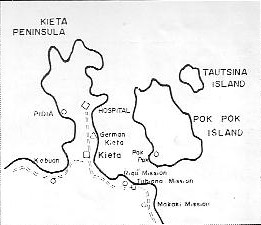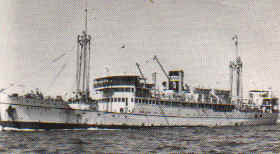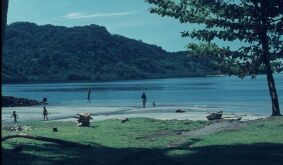|
Historic Kieta

Kieta, nestling against the calm waters of the bay that bears its name, has always played an important part in the story of Bougainville. From 1900, when Marist missionaries bought the first land, to 1970, when it became the boom port of entry to the Project, something has always been going on in Kieta. The first Europeans to land at the Kieta Peninsula came to take things away. Whalers and beche-de-mer ships hunted the produce of the nearby ocean, while blackbirding vessels came to trade in human lives to work the Queensland plantations or those of German Samoa and of Fiji. In the late 19th Century the North Solomons came under the German "sphere of influence". Marist missionaries fanned out from Samoa into Melanesia, but they did not arrive at Bougainville until 1900 when they landed at Kieta. A sale of land was immediately arranged with a Pok Pok chief called Serai. Some 35 hectares were bought near Rigu for 10 axes, 10 work knives, 20 length of cloth, a box of beads and a six-oared whaleboat. The sale was not made without some resentment from the Rigu people, and a year later two schoolboys were killed during the ensuing land dispute. The missionaries left the island but returned again in 1903. The same year a Marist Mission was opened at Buin, then in 1904 at Koromira, in 1910 at Buka, during 1911 at Banoni (Torokina) and at Tinputz in 1918. The mission land at Kieta was on the hill not far from the present Tubiana Mission, and was called Makaki. Today, all that still stands is the church and graveyard, overgrown and neglected. In 1905 the German Government opened an Administrative station at Kieta under the control of August Doellinger. By 1914 a mission boat, the Kulanbangara, serviced the area and the total European population of Bougainville was 45, of whom 23 were missionaries. War meant the end of the German regime and the hoisting of the Australian flag, although it was not until 1920 that military administration gave way to civil. A sub-district office was set up at Kieta, the district office being at Sohano in Buka Passage. For the next 20 years Kieta grew little by little. The township moved from the old German site, where the sub-district office is now, and slowly took root within the limited land space of the present location. Expropriation Board plantation managers and the mission came to town occasionally to shop at the new Chinese trade stores, and the occasional trading schooner moored in the harbour.
The Japanese were soon gone, and Kieta licked its wounds and carried on as before. Today, little evidence can be found of this period beyond a solitary Japanese gun standing outside the sub-district office. Through the '50s and early '60s Kieta remained a sleepy port with its usual South Seas assortment of Chinese and Australian stores, missions, administration offices, plantation workers and the occasional beachcomber. Then in 1964 the C.R.A. exploration geologists arrived to prospect the hills around Panguna for copper; they stayed at the newly opened Kieta Hotel, and at Aropa Plantation. As prospecting revealed large copper deposits, from C.R.A. was born Bougainville Copper Pty Ltd. And as the latter decided to go ahead with the Project, Kieta was the obvious port to handle the massive shipments of materials needed. Overnight it became a boom town.
Courtesy PANGUNA-The Voice of Bougainville Copper |

 Burns Philp arrived in the 1930s, bringing with it a shipping service
from the mainland in the Malaita. In 1942 war broke out again,
and Kieta found itself under the flag of the Rising Sun.
Burns Philp arrived in the 1930s, bringing with it a shipping service
from the mainland in the Malaita. In 1942 war broke out again,
and Kieta found itself under the flag of the Rising Sun.
 Today it has a population of just over a thousand. There are 13 trade
stores, a supermarket, cinema shows at the Kieta Club and the nearby
high school, two hotels (including the newly opened Davara at Toniva),
a deepwater harbour, three banks and enough traffic to cause city-style
congestion.
Today it has a population of just over a thousand. There are 13 trade
stores, a supermarket, cinema shows at the Kieta Club and the nearby
high school, two hotels (including the newly opened Davara at Toniva),
a deepwater harbour, three banks and enough traffic to cause city-style
congestion.